I initially wrote about my best, go-to new baby gift about 10 years ago. It’s been one of my most popular posts over the years, but it is long overdue for an update.
As a pediatrician, I have definite ideas about what every new mom should have in their medicine cabinet. I started giving out my “new baby kit” about 14 years ago, my sister in law received the first version back when I was a pediatric intern. I created the original kit with the help of my dad, who is now a retired pediatrician of almost 40 years, he now blogs for fun over at 101 Cooking for Two.
The idea is that this kit contains all the medicines and other items that a new mommy would want to have on hand, and they’d all be pediatrician approved! Note, I also give away the Post Partum Recovery Kit, but that’s only for friends that I know really well! You have to have a special relationship to buy someone giant maxi pads!
The first item in the kit is always the 1. AAP’s Your Baby’s First Year. This book is huge, I think it’s really a reference book and not something to read cover to cover. It is where you look when your baby has a cold, if you are curious about development, etc. I’ve looked at pretty much every other book out there, and this is the best one. Now that I’m actually a practicing pediatrician too (though granted I’m in the ICU), I judge these books based upon their fever recommendations. Most of the others are NOT ones I recommend, I’m somewhat concerned about most of them, actually. Especially under a month of age, fever is something to be taken very seriously (it can be the only symptom your baby has meningitis!) so, this is the only one to get!
Random items… I think every parent likely goes crazy with Purell when they have a little one in the home. Especially during the winter when viruses are out there like RSV and the flu, keeping people who are sick away from the baby and encouraging a little hand hygiene can go a long way!
I have 2 lotions that I used on my daughters, and they’re what I was taught to recommend to parents when I was in my peds training. Cetaphil cream is a great hydrating lotion that is thick and gentle without being sticky. For times that the skin is more dry or you need more of a barrier, Aquaphor is the way to go. Aquaphor is more greasy and can feel sticky, but it’s perfect on my daughter right now to protect her cheeks from the cold, I use it as a cuticle cream and I have friends that swear by it as a lip balm even!
Neosporin… Seriously, it’s just kind of amazing. I used to include hydrocortisone cream in here too, but no longer do. I know that I know when to use it and when to stop (after 5 days you need to stop because you can get skin atrophy and other problems), but not everyone knows. So, only use hydrocortisone when your pediatrician tells you. I no longer give it out.
Check for Fever
There isn’t much you can do when your little one gets a cold other than keep their nose sucked out and keep them comfy. Cough and cold preparations are no longer recommended under age 2, studies found they didn’t really work and had a lot of side effects. We usually recommend sucking out the nose, and you can put a drop or two of the Saline in the nose to loosen things up. The hospital sends new moms home with the blue bulb syringe and yes, that blue bulb syringe is the best one out there. Stock up on Amazon!
I do not recommend the fancy thermometers that work via your forehead, or usually even the ear. They’re very user dependent and you can get wildly different reading depending upon what the product wants to tell you, you should hear some of the temps parents tell me later in the hospital. For babies, your pediatrician will want a rectal temp, nothing else matters. (And guess what? Turns out that touching the forehead isn’t very accurate to diagnose a fever. If they feel warm, check it!) I recommend a basic, digital thermometer.
I use thermometer covers so I know that the thermometer is clean later. I also use a little KY Jelly on the thermometer when inserting it, but I felt funny putting that picture here. Be kind, lubricate!
Diaper Creams
Oh, the controversy! People feel very passionate about butt creams for some reason.
So, there are really 2 basic types of diaper creams: Treatment creams that have zinc oxide to soothe irritation and barrier creams that protect the skin from pee and poo. The barrier creams don’t treat anything really, they’re there to prevent irritation.
Desitin and Butt Paste are both treatment creams, and they both have the same active ingredient, so with minor variations in the rest of the cream they’re essentially the same thing (if you look closely at the boxes above they both say 40% zinc oxide). Sometimes one might work better for your child than the other. We used Desitin on my daughters, I know a ton of Butt Paste devotees. I like to give a tube of each to new moms, then they can try them both out when the need arises.
A&D is for every day, every diaper use when your little one’s bum is easily irritated or you think a little irritation is there and you’re not quite ready for a zinc oxide cream. It lets the skin heal on its own.
If you know that you’ll be cloth diapering (which I did for the first 16 months), then none of those creams are compatible with your diapers. They’ll leave a film that repels moisture rather than absorbing. In that case, you want Grandma El’s. This is a barrier cream similar to A&D, and it washes away completely so you can use it with cloth diapers. If you really need to treat a diaper rash, I’d use a zinc oxide with a liner, or strip my cloth diapers to remove the film later. We didn’t have any rashes to treat until my daughter was over 2 and in disposables, and I’ve heard this is pretty typical.
So, I give the Desitin, Butt Paste and A&D to new moms, I’ll substitute Grandma El’s if I know they’ll be cloth diapering.
I do like to give new moms these basic baby medicines to keep on hand (who wants to make a run to the drugstore for Pedialyte with a barfing 6 month old?), but I put notes on them regarding use.
First, the Tylenol and Motrin should be dosed according to what your pediatrician says in your child’s dose. It is weight based, and you’ll get a much more accurate dose from your doctor than from using the dose range on the box.
Second, remember that Tylenol and Motrin aren’t the same thing. Tylenol can be given every 4 hours until you hit a max number of doses in a day, and if you’re going to use it around the clock you should be using it every 6 hours. Motrin is every 6 hours and if there are any kidney issues or dehydration you should avoid it. I’ve shown the name brands here, but there are other brands with the same active ingredients, and they come in different flavors.
In my note on these 2 medications, I say to dose according to your doctor and pay attention to the dosing interval. As well, under 6 months I actually say to not start using them until you talk to your pediatrician. I don’t want people ignoring an important fever or fussiness that could be a symptom of something worse! But, I do think having these in the house already is very helpful.
Pedialyte does taste gross, but has the best balance of electrolytes when you are rehydrating your kiddo. When they’re thirsty, they will still drink it! The only thing better is the WHO’s Oral Rehydration Solution, no rice milks, soda or juices. There are different flavors, and I’ve shown Grape because I found a picture, but there isn’t a lot of taste. I prefer clear or orange because I think they’re easier to get out of fabrics if they get barfed up later.
Finally, you do not want to wake up to a crying baby in the middle of the night because of teething and not be prepared! I always include a few teething options in the kit. The circle on the left can be frozen before chewing on it, that was my daughter’s favorite while teething. The ring Sophie the Giraffe is also great, there’s also the classic plain Giraffe. Other options include freezing was wet washcloth for chewing, frozen waffles, frozen mini-bagels and frozen Twizzlers (caution, the red will stain things!). There are quite a few oral gel pain relievers out there, and we did try Oragel at my house, but it isn’t a huge help because they basically wash the medication away right away with saliva. Worth a try though! As well, trying Tylenol or Motrin if the baby is really uncomfortable.
A note about teething tablets: I was taught to discourage parents from using them. Why? One of the main ingredients is Belladonna, and if you overdose there are pretty dire consequences. I can’t even tell you how many adventurous teens I’ve admitted to the ICU with anti-cholinergic syndrome because of Belladonna. If you do chose to use teething tablets, please pay careful attention to the directions and don’t over use them.
That’s the kit! What else would you include?
Don’t forget to check out my Post Partum Recovery Kit too!

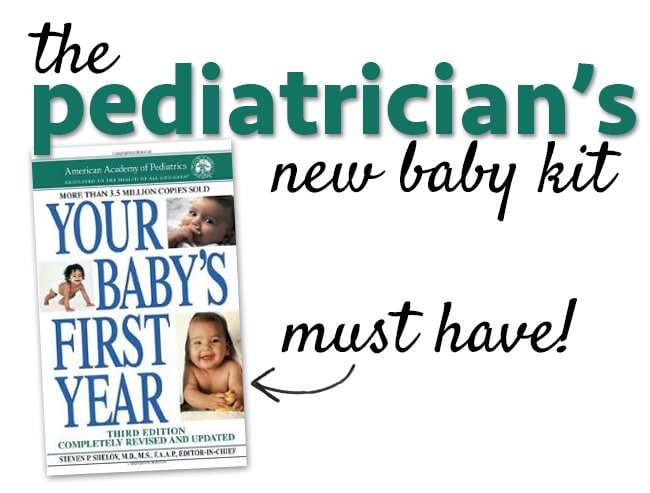
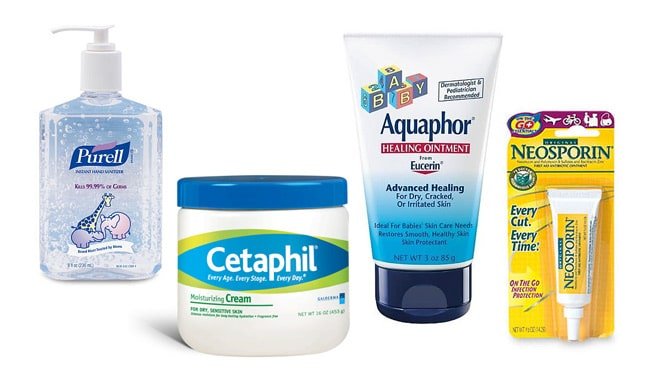
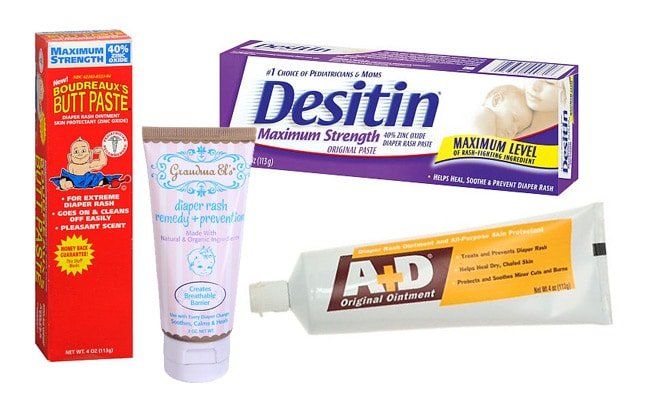
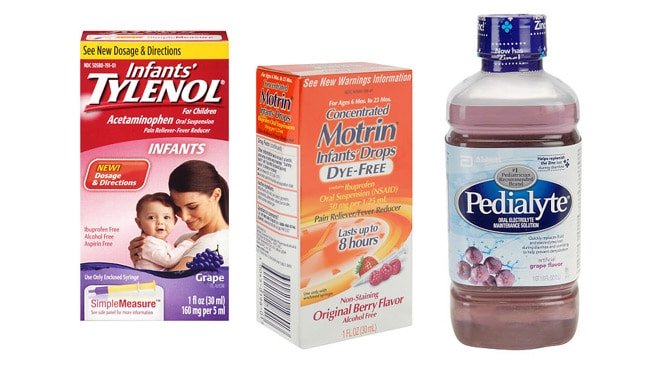
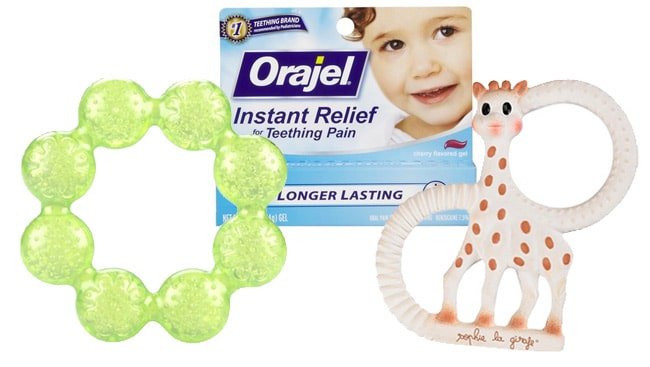
 I’m a doctor, a mommy and a bit of a beauty addict. If you let me, I can take 2 hours to get ready in the morning. Really. I'm on a quest for faster beauty that works!
I’m a doctor, a mommy and a bit of a beauty addict. If you let me, I can take 2 hours to get ready in the morning. Really. I'm on a quest for faster beauty that works!
Love this… For so many reasons!
Tylenol Suppositories. Those saved my life when one of my kids would always puke up tylenol!
Great tips, particularly the oragel. That kept my baby nice and quiet on a flight to Boston, earlier this year. Thanks!
Tip for checking for a temperature before you grab the thermometer: feel their neck. That's not as exposed to the air and it's right over a major pulse too. I just about never fail to pick up a fever; the thermometer just tells me how worried I should be about it.
Oh and, with the teething tablets, that's homeopathic medicine. So there is barely any belladonna in it, if any period. In fact a lot of people think it's quack medicine *because* of there being no active ingredient worth speaking of. We used them anyway, and I'm not sure if they actually worked or if it was placebo effect because my daughter knew we were looking after her and automatically felt better.
Orajel will not work with all kids. Some people react weirdly to the active ingredient. I know that with the adult formulations of painkiller gel for gums, those actually *make* me hurt. So watch out for that.
If the Belladonna is listed as an active ingredient, there's enough there to be clinically active, it is not something that they just add for fun. Just because something is "natural" doesn't mean that it is safe, and the fact is that because it is homeopathic there are a lot of people that will assume that it is completely safe and keep dosing their kids. It has no pain effects, instead it is an anti-cholingeric and depends mostly on the anti-cholinergic syndrome effects (http://familypracticepearls.blogspot.com/2011/04/classic-anticholinergic-side-effects.html) to make the baby think there isn't any pain. That's why in my pediatrics training I was taught to advise parents not to use it and I don't include it when giving this kit to friends.
I would also recommend a baby nasal aspirator with a tube so you can suck on one end, I often recommend this for my patients’ and mom’s often swear by it! Could also maybe include some Ovol (simethicone) drops in case of upset tummy. Not sure what’s available where you practice but I’m a pharmacist in Canada and these things are a must for a new baby in my opinion 🙂
So simethicone I don’t routinely recommend as there are quite a few studies that it doesn’t actually help infants. It won’t hurt, but mostly it helps parents who are concerned about gassiness feel like they have done something. I recommend discussing with your pediatrician if the baby is that fussy first to make sure nothing is being missed.
As well, I actually greatly prefer the blue bulb syringe over the nasal aspirators (in the US Nose Frieda is the most popular one). I think those are a bit harder to use, but it is also easier to overdo it and cause some trauma to the nose. In any >6 months of age that would be ok, but in a neonate who is an obligate nose breather, nose swelling can cause more issues. I counsel parents to try the bulb syringe first and do the nasal aspirator if they really want to try it, but they need to be careful with it.
As a pediatrician, I would not recommend orajel. The ingredient in it can cause a numbing effect and cause apnea. In addition, saliva typically washes it away and has not been shown to work well as a result. Infant Tylenol or a cold teething ring can be used instead if your baby is fussy and in pain.
Note, I’m also a pediatrician (PICU trained/boarded) The apnea is a few case reports, I have never seen it nor do I know anyone that’s actually seen it. It does get washed away easily, but a small amount when used correctly is fine.